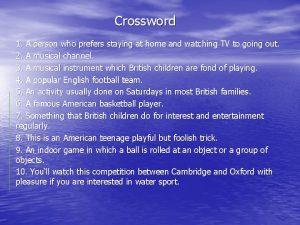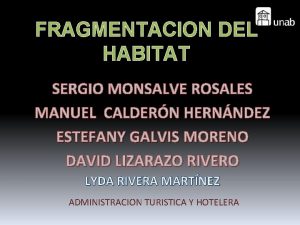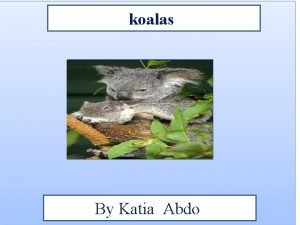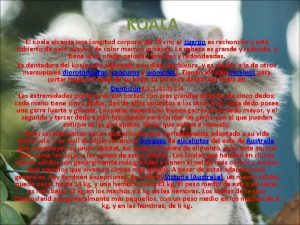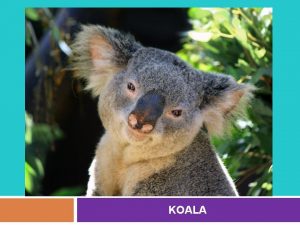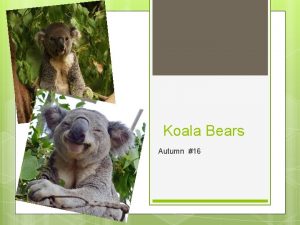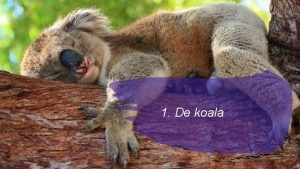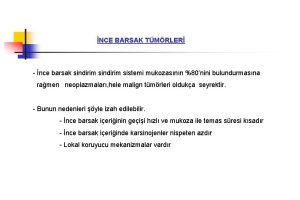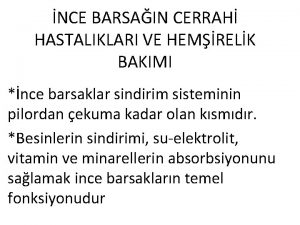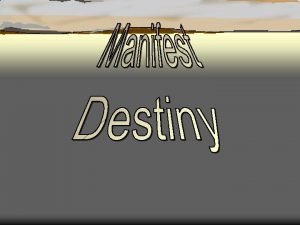NCE Hinterland Whos Who Koala The Koala prefers





















- Slides: 21

NCE Hinterland Who’s Who

Koala The Koala prefers to move around neither in daylight or night, but rather just after sunset. Usually daytimes are spent asleep in the fork of a tree, as 80% of its time is spent sleeping. The baby Joey is born five weeks after conception, blind, hairless and less than an inch long. It then crawls into its mothers pouch and drinks from one of the 2 teats there. The next 6 months, the baby stays in the pouch drinking milk. During the next period, before being weaned at around the age of 1, their dietary needs are supplemented by eating some of the mother's faeces that supplement the bacteria in its own caecum (part of the intestine).

80% of time spent sleeping

Tawny Frogmouth Owl From place to place it varies markedly in size and colour (ranging from grey to dull rufous). Normally, it has large yellow eyes and a heart shaped bill. As with all frogmouths, it has a bristly feathered tuft over its bill and an extremely long tongue that is forked. It usually hunts by pouncing from a low perch, such as a fence post or road sign, on to small terrestrial animals crossing bare open ground (eg country roads) at dusk and dawn. The chief prey are such arthropods as centipedes, spiders, scorpions and cockroaches, but it also eats frogs, mice and - occasionally - small birds.

pounces from a low perch

Emu A flightless bird, (Ratite), there is only one species of Emu, which is the world’s 2 nd largest bird behind the Ostrich. Emus are very mobile quick runners, (up to 50 kph), running with a bouncy, swaying motion. Emus are generally nomadic, with some emus roaming over hundreds of kilometers.

the world’s second largest bird

Sea Turtle Sea turtles are graceful saltwater reptiles, well adapted to life in their marine world. With streamlined bodies and flipper-like limbs, they are magnificent swimmers able to navigate across the oceans. When they are active, sea turtles must swim to the ocean surface to breathe every few minutes. When they are resting, they can remain underwater for much longer periods of time.

graceful saltwater reptile

Red Kangaroo They normally move in groups ranging from a few dozen to several hundred individuals, which are known as Mobs. The makeup of the red kangaroo mob varies but usually consists of a dominant male, a number of adult females, and juveniles of both sexes. Red Kangaroos are able to survive temperatures in excess of 40°C by using shade and avoiding activity during the day. Red Kangaroos also concentrate their urine to conserve water and thus can tolerate severe dehydration. They regulate their body temperature largely by panting and licking their forearms.

stays in shade, avoids activity during the day

Frilled Neck Lizard 5 step defence plan 1) If it sees danger, it slowly cringes down onto the ground looking like a stout stick, relying on its natural body colours to act as camouflage. 2) If the lizard feels threatened, it will extend its legs and open its mouth widely, thus erecting the frill in a blaze of startling colour. 3) To add to the bluff, it may hiss and jump towards the threat. 4) If the frill and hissing is not effective, the frilled lizard menaces "the threat" by repeatedly lashing its tail on the ground. 5 a) The frilled lizard as a last resort prefers to run rather than fight by making a sudden turn and running off, on its hind legs, to the nearest tree, which it climbs until out of reach. 5 b) But if forced to fight, this lizard can inflict painful bites with its large canine teeth. Its fearsome bluff though is no match for its biggest enemy, feral cats.

bluffs by hissing and jumping

Bandicoot They are nocturnal, foraging for food at night and during the day living in their leaf and vegetation lined nests, often in logs, crevices or scrapped out burrows or tunnels. They are very solitary animals and will chase other bandicoots away except in their mating seasons. When called to fight they use their hind legs and bite only as a last resort. The bandicoot can often be heard sniffing at night time whilst searching for food or issuing shrill whistles and grunt-like sounds when food is found.

nocturnal, issues whistles and grunt-like sounds

Bald Eagle The bald eagle stands 2 1/2 to 3 feet tall with an impressive 6 l/2 to 7 1/2 foot wingspan. Its keen eyesight is eight times more powerful than a human's. The bright yellow feet of adults are strong, unfeathered and equipped with long, sharp, black talons for penetrating and grasping prey. The powerful, bright yellow, hooked bill is used for tearing and dismembering prey.

hooked bill tears and dismembers prey

Estuarine Crocodile The feeding strategy of a salt water croc is to wait close to the water's edge and pounce upon its victim in the blink of an eye. The usual prey of younger crocs is smaller animals, such as fishes and crustaceans. Adults can also attack and eat larger animals by overpowering and then drowning them, (the teeth are designed more for holding), eg fish, turtles, birds, turtles, reptiles and mammals (dingoes, wallabies) - even domestic cattle and people. After the prey is dead, the croc will break the prey up into smaller pieces by violent flicking of the head to snap or break bones or twisting and rolling the body. Larger crocs will also take carrion if hungry.

eats carrion if hungry

The Hairy Nosed Wombat The northern hairy-nosed wombat is a marsupial, eats mostly grasses and bears one young per litter. It is nocturnal, spending the day in a burrow and coming out at night to feed. It is completely terrestrial and well equipped with short, powerful legs and long, strong claws for digging its large, often complex system of burrows. The northern hairy-nosed wombat lives in a harsh climate with very hot summers and long periods of dry weather. It copes by minimizing the amount of time spent above ground and choosing the most comfortable times of night for excursions (although it will sun itself on winter afternoons).

suns itself on winter afternoons
 University of hong kong
University of hong kong Hinterland definition ap human geography
Hinterland definition ap human geography Hinterland kota adalah
Hinterland kota adalah Borchert's epochs ap human geography definition
Borchert's epochs ap human geography definition Nce raufoss
Nce raufoss Nce
Nce Mil-std-461e 한글 pdf
Mil-std-461e 한글 pdf Prefer to do or doing
Prefer to do or doing Prefers crossword
Prefers crossword Prefer+
Prefer+ Does mla prefers times new roman
Does mla prefers times new roman Peter prefers swimming
Peter prefers swimming Koala
Koala Wat eet een koala
Wat eet een koala Koala tous
Koala tous You what
You what Decal koala fingerprint locations
Decal koala fingerprint locations Lokaal loket kinderopvang
Lokaal loket kinderopvang Koala taxonomy
Koala taxonomy What is a koalas life cycle
What is a koalas life cycle Koala physical features
Koala physical features Koala masa corporal
Koala masa corporal








